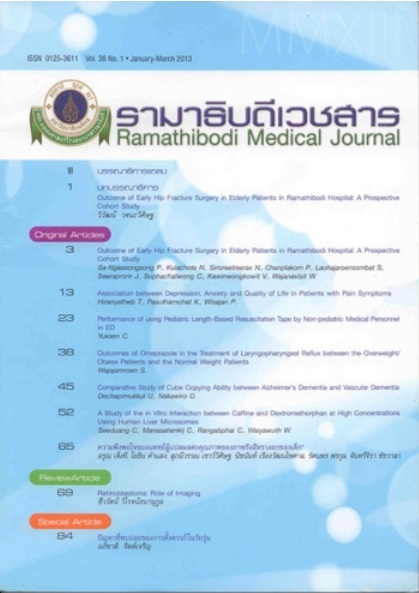Performance of using Pediatric Length-Based Resuscitation Tape by Non-pediatric Medical Personnel in ED
Keywords:
Pediatric Lengt-Based Resuscitation TapeAbstract
Background: Age and size-related issues in pediatric patient affect resuscitation in ED. In Thailand, lacking of specialist in ED is an important problem. Most of pediatric patient are treated by non-pediatric physicians who may have less skills and experience in pediatric care. Medical errors and delay in pediatric resuscitation are more common problems in ED than adult resuscitation.
Objective: To study how the lenght-based resuscitation tape can reduce time and errors when it is used by non-pediatric personnel to trat pediatric patient in ED.
Methods: 3 groups of participants (6th year medical students, non-pediatric residents, pediatric residents) were asked to complete 4 paper-based tests about pediatric resuscitation using both method (2 tests by conventional method and 2 tests by using Pediatric Lenght-Based Resuscitation Tape: PED card). Completion time and number of errors were recorded and compared.
Results: 87 participants were attened in this research. In 6th year medical students and non-pediatric resident, using PED card can reduce completion time and number of errors in all 4 paper-based tests compared with conventional method (P < 0.05). In pediatric residents or pediatricians, using PED card still reduce number of errors in all 4 paper-based tests compared with conventional method (P < 0.05), but completion time in both methods are not different.
Conclusions: Using PED card in pediatric resuscitation by non-pediatric medical personnel can reduce time and medical errors compared with the conventional method in ED.
References
Stefl ME. To Err is Human: Building a Safer Health System in 1999. Front Health Serv Manage. 2001;18(1):1-2.
Rowe C1, Koren T, Koren G. Errors by paediatric residents in calculating drug doses. Arch Dis Child. 1998;79(1):56-8.
Lifshitz AE, Goldstein LH, Sharist M, et al. Medication prescribing errors in the prehospital setting and in the ED. Am J Emerg Med. 2012;30(5):726-31. doi:10.1016/j.ajem.2011.04.023.
Vilà-de-Muga M, Colom-Ferrer L, Gonzàlez-Herrero M, et al. Factors associated with medication errors in the pediatric emergency department. Pediatr Emerg Care. 2011;27(4):290-4. doi:10.1097/PEC.0b013e31821313c2.
Rinke ML, Moon M, Clark JS, Mudd S, Miller MR. Prescribing errors in a pediatric emergency department. Pediatr Emerg Care. 2008;24(1):1-8. doi:10.1097/pec.0b013e31815f6f6c.
Luten R, Wears RL, Broselow J, Croskerry P, Joseph MM, Frush K. Managing the unique size-related issues of pediatric resuscitation: reducing cognitive load with resuscitation aids. Acad Emerg Med. 2002;9(8):840-7.
Harris M, Patterson J, Morse J. Doctors, nurses, and parents are equally poor at estimating pediatric weights. Pediatr Emerg Care. 1999;15(1):17-8.
DuBois D, Baldwin S, King WD. Accuracy of weight estimation methods for children. Pediatr Emerg Care. 2007;23(4):227-30.
Rosenberg M, Greenberger S, Rawal A, Latimer-Pierson J, Thundiyil J. Comparison of Broselow tape measurements versus physician estimations of pediatric weights. Am J Emerg Med. 2011;29(5):482-8. doi:10.1016/j.ajem.2009.12.002.
Varghese A, Vasudevan VK, Lewin S, Indumathi CK, Dinakar C, Rao SD. Do the length-based (Broselow) Tape, APLS, Argall and Nelson's formulae accurately estimate weight of Indian children?. Indian Pediatr. 2006 Oct;43(10):889-94.
Jang HY, Shin SD, Kwak YH. Can the Broselow tape be used to estimate weight and endotracheal tube size in Korean children?. Acad Emerg Med. 2007;14(5):489-91.
Shah AN, Frush K, Luo X, Wears RL. Effect of an intervention standardization system on pediatric dosing and equipment size determination: a crossover trial involving simulated resuscitation events. Arch Pediatr Adolesc Med. 2003;157(3):229-36.
Yamamoto L, Kanemori J. Comparing errors in ED computer-assisted vs conventional pediatric drug dosing and administration. Am J Emerg Med. 2010;28(5):588-92. doi:10.1016/j.ajem.2009.02.009.
Hegenbarth MA. Preparing for pediatric emergencies: drugs to consider. Pediatrics. 2008;121(2):433-43. doi:10.1542/peds.2007-3284.













